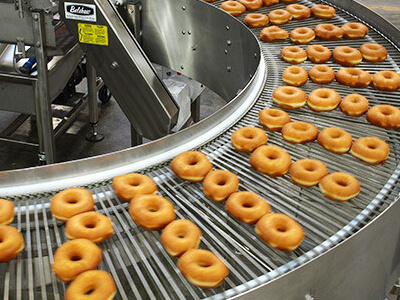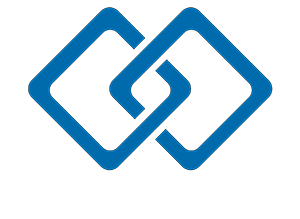Ladder Conveyor Belts
HOME / PRODUCTS / Metal Conveyor Belts / Ladder Conveyor Belts
Ladder Conveyor Belting Straight & Radius Running | Simple Structure Versatile Functio
Ladder conveyor belt , also known as ladder track belting, rod conveyor belts, is a straightforward yet efficient style of conveyor belt that is often utilized in bakeries. This type of conveyor belt features an open design, which contributes to its effective operation with minimal maintenance requirements. The simplicity of the ladder track design not only ensures smooth functioning but also facilitates easy and thorough cleaning processes. This is particularly advantageous in bakery settings where hygiene is crucial. The openness of the structure allows for efficient removal of debris and facilitates sanitation practices.
Specification
| Rod pitch | 12.70 – 30.00 mm |
| Rod diameter | 3.66 – 8.00 mm |
| Maximum width | 9600 mm |
| Standard materials | Carbon Steel, SS 304, SS 316. |
| Working temperature | up to 350°C |
| Edging | loops (S) |
| Running | Straight and radial |
Belt Types


Straight Running Ladder Conveyor Belts
Straight running ladder conveyor belts are a specific type of conveyor system designed to operate in straight-line applications. These belts are characterized by a series of parallel, interlinked slats or rods that form a ladder-like structure. The primary design intent of straight running ladder conveyor belts is to operate in a linear or straight-line fashion. This makes them suitable for applications where materials or products need to be transported in a continuous, uninterrupted manner.
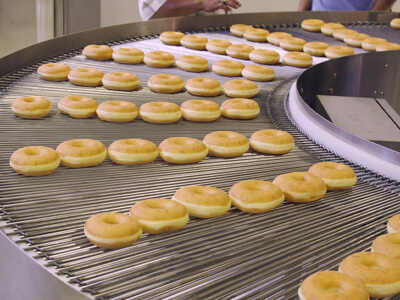

Radial Running Ladder Conveyor Belts
Radial running ladder conveyor belts are a specialized type of conveyor system designed to operate in radial or curved applications. Unlike straight running ladder belts that primarily move in a linear fashion, radial running ladder conveyor belts are configured to navigate turns and curves smoothly. The primary characteristic of radial running ladder conveyor belts is their ability to operate in curved or radial paths. This makes them suitable for conveyor systems where materials need to be transported around bends, turns, or circular layouts.
Edge Availability
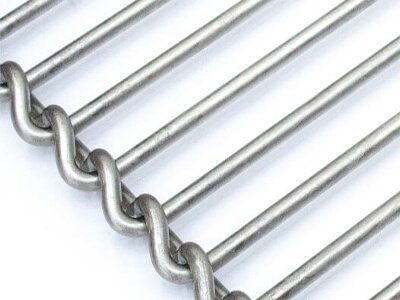

Ladder Conveyor Belts edge with S loops in the same direction
The edges of the ladder conveyor belt are designed with S-shaped loops that face the same direction. This configuration provides additional structure and support to the edges of the belt. The S loops in the same direction contribute to increased stability along the edges of the conveyor belt. This enhanced stability is particularly beneficial when the belt is conveying products or materials that may have a tendency to shift or become unstable during transport.
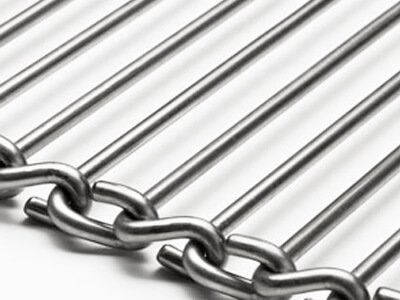

Ladder Conveyor Belts edge with S loops in the different direction
Ladder conveyor belts with edges featuring S loops in different directions have a specific edge configuration that distinguishes them from belts with S loops in the same direction. The S loops in different directions contribute to enhanced edge reinforcement on both sides of the conveyor belt. This dual-directional reinforcement can provide increased stability and prevent material spillage, especially when conveying products that tend to shift or have irregular shapes. The opposite S-loop directions can contribute to improved edge tracking. This may enhance the conveyor belt's ability to maintain alignment during operation, reducing the risk of misalignment issues.
Methods of Drive
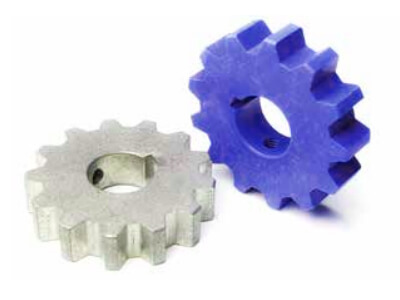

Sprocket Drive
Sprocket drive is a common method for ladder conveyor belts. The belt features evenly spaced openings that engage with sprockets, providing positive drive. This method ensures precise tracking and is suitable for straight or curved conveyor applications.
Common Specifications of Ladder Conveyor Belts
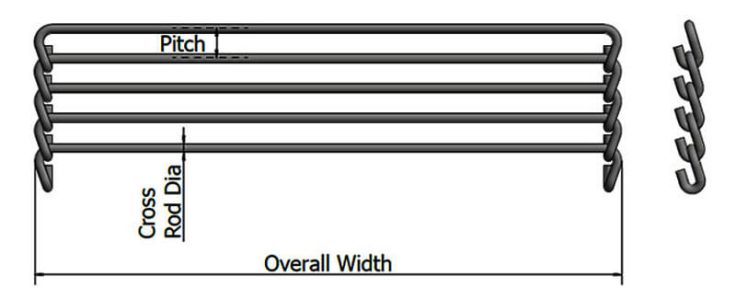

| Specifications for straight-running ladder belt | |||
| Item | Pitch | Rod diameter | Maximum width |
| mm | mm | mm | |
| SYLB01 | 12.7 | 3.66 | 762 |
| SYLB02 | 15.87 | 4.47 | 914 |
| SYLB03 | 19.05 | 4.88 | 914 |
| SYLB04 | 25.4 | 4.88 | 914 |
| NOTE: Custom specification is available if you can’t find the suitable size. | |||
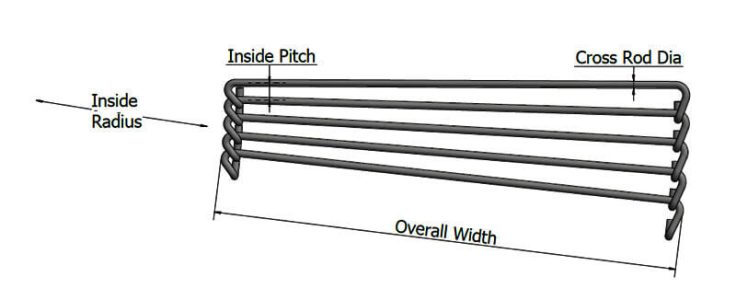

| Specifications for radial ladder belt | ||||
| Item | Pitch | Rod diameter | Inside Radius | Available width |
| mm | mm | mm | mm | |
| SYLBR01 | 12.7 | 3.66 | 598.5 | 229/305/381/457/762 |
| SYLBR02 | 15.87 | 4.47 | 762 | 305/381/457/610/762 |
| NOTE: Custom specification is available if you can’t find the suitable size. | ||||
Ladder conveyor belts offer several advantages in various industrial applications due to their unique design and characteristics.
• Efficient Operation
The open structure of ladder track allows for efficient airflow, which is particularly beneficial in baking processes. This can help in the even baking of products.
• Easy Cleaning
The open design facilitates easy access for cleaning. In bakery environments, where hygiene is crucial, the ability to clean the conveyor belt thoroughly is essential. Ladder track’s design allows for easy removal of debris and makes sanitation processes more effective.
• Flat Uniform Surface for Gentle Product Handling
The flat and uniform surface of ladder conveyor belts provides a smooth and consistent platform for product handling. This is particularly important in applications where delicate or sensitive products need to be transported without the risk of damage.
• High Tensile Rods for Resistance to Permanent Distortion and Reduced Downtime
The use of high-tensile rods in ladder conveyor belts contributes to their durability and resistance to permanent distortion. This feature enhances the overall reliability of the conveyor system, reducing downtime and maintenance requirements.
• Positive Drive to Ensure No Tracking Issues
The positive drive mechanism of ladder conveyor belts ensures precise tracking without issues. This is crucial for maintaining the alignment of the belt, preventing misalignment problems that can lead to disruptions in material flow and increased wear on the conveyor components.
• Smooth Edges for Easy Movement around Radial Bends
Smooth edges on ladder conveyor belts facilitate easy movement around radial bends. This is especially beneficial in applications where the conveyor needs to navigate curved paths, ensuring that products move smoothly without snagging or catching on the belt.
• Easy Belt Assembly and Disassembly Due to Simple Open Construction
The simple and open construction of ladder conveyor belts makes them easy to assemble and disassemble. This feature simplifies maintenance tasks, reduces downtime during belt replacement, and enhances overall operational efficiency.
• Straight and Curved Applications with Fixed Inside Radius
The ladder belt with S-shaped hooks is designed to run seamlessly in straight applications, providing a reliable and consistent surface for material handling. Additionally, its versatility allows for execution as curved belts with a fixed inside radius. This makes it suitable for conveyor systems that require both linear and curved sections.
• Standard Belts for 90° or 180° Conveyor Angle
Standard belts for 90° or 180° conveyor angles enhance the adaptability of the ladder belt to different operational configurations. This standardization simplifies the selection process for conveyor systems, ensuring compatibility with the desired conveyor angle of operation.
Ladder belts find application in various industrial processes due to their unique characteristics. Here’s a breakdown of their use in different settings:
• Cooling Systems in Bread & Pastry Industry
These belts are commonly used in cooling systems within the bread and pastry industry. Their open design allows for efficient airflow, aiding in the cooling process of freshly baked products.
• Belt in Filtering Installations
The flat and uniform surface of ladder belts makes them suitable for use as belts in filtering installations. Their design allows for the effective separation and filtering of materials in industrial processes.
• Conveyor Belt in Baking, Frying, Grilling, etc
These belts are extensively used as conveyor belts in various cooking processes such as baking, frying, and grilling. Their durability, efficient operation, and resistance to distortion make them ideal for conveying products through these high-temperature processes.
• Execution as a “Batter-Belt” for Strengthening
When configured as a “batter-belt” with bar links and lateral chains, ladder belts are employed to handle batter and other heavy or irregularly shaped loads. The additional strength provided by bar links ensures the reliable conveyance of such materials.
• Washing Systems
Ladder belts are well-suited for use in washing systems, particularly due to their open design that facilitates easy access for cleaning. This is crucial in applications where hygiene is a top priority.
• Drying Systems
The open structure and efficient airflow of ladder belts make them suitable for use in drying systems. Whether in food processing or other industrial applications, ladder belts can effectively convey products through drying processes.

